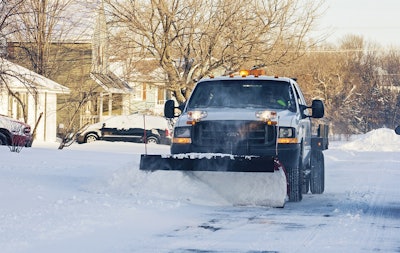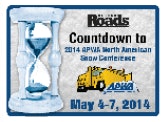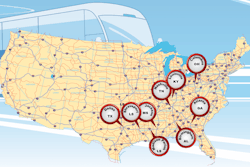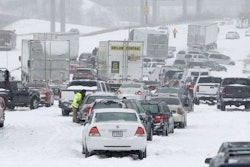Through some trial and error in storage, different application equipment and roadway applications, one city’s continued use of liquids has evolved into innovative treatment methods.

Last month, Better Roads covered how professional-grade salt-brine making, blending and truck loading systems are being used as a mobile solution for municipalities and state agencies to help prevent crippling situations. These included severe weather hit Atlanta and Texas; how a group of stakeholders in Ohio created a set of salt-storage guidelines, “Recommendations for Salt Storage Guidance for Protecting Ohio’s Water Resources;” and how the blended liquid deicers were used for anti-icing and pre-wetting, how multi-edge snowplows and highgate wheel loader plows hit the scene, and how an Automatic Vehicle Location (AVL) system for snow and ice control management were implemented.
In this issue, Better Roads shares more technologies and techniques as the highway and bridge building industry’s snowfighters gear up for the American Public Works Association (APWA) Snow Show May 4-7 in Cincinnati, Ohio (For more information, go to apwa.net/snow).
A small city big on liquids, Cuyahoga Falls, Ohio, with a population of a little more than 50,000 and almost 500 lane miles, has a long and strong history with the use of liquids in snow and ice control. In 1966, the city drilled a well 2,700-feet deep into a salt vein for water softening purposes for the Water Treatment Plant. Fresh water was pumped into the salt vein, and the product that came back out of the ground was a rich concentration of natural salt brine. The city’s Streets Department, spurred by this vast supply of natural brine, began using it for snow and ice control by the mid-1970s.
“Through some trial and error in storage, different application equipment and roadway applications, the city’s continued use of this valuable money saving product has evolved into some very innovative treatment methods in its winter maintenance program,” says Charles Novak with the City of Cuyahoga Falls, Ohio’s Street Department. “From anti-icing to deicing, the city has employed treatment methods proven to reduce salt consumption, achieve great results and save money both directly and indirectly.”
 Through trial and error in storage, different application equipment and roadway applications, the City of Cuyahoga Falls, Ohio, has developed some innovative treatment methods in its weather maintenance program.
Through trial and error in storage, different application equipment and roadway applications, the City of Cuyahoga Falls, Ohio, has developed some innovative treatment methods in its weather maintenance program.The city also tries to be on the forefront of innovation and technology and has a long history of the use of high-volume spreaders that not only pre-wet solids but apply liquids at greater rates achieving high levels of service with minimal resource requirements, Novak says. The city currently owns the largest municipal fleet in the country of these high-volume liquid spreaders, and data shows they have paid themselves off within a few years through a dry-salt savings.
Novak will be presenting at the APWA Show about the positive outcomes achieved through liquid application in snow and ice control and offers a methodology that can be applied across the country to others who want to incorporate such treatments in their winter maintenance strategies.
“With literally decades of use of liquids in snow and ice control, Cuyahoga Falls’ experience can provide a footprint to helping others understand and apply practical knowledge required to successfully incorporating liquids as a major treatment type,” Novak says.
It’s no secret that winter maintenance has an impact on freshwater systems – i.e. salt and chemicals – getting into watersheds, but it’s necessary. So understanding the best practices for moving ahead with snow and ice control is both effective and important.
In Minnesota, there is a statewide training program that more than 5,000 maintenance professionals have attended and have become state certified in the practices. Now, the program is working on its first major impaired waters project for chlorides throughout a seven-county metro area, says Connie Fortin, founder and president of Hamel, Minnesota-based Fortin Consulting.
“We are developing a computer-based winter maintenance assessment tool to help organizations assess at a very detailed level their maintenance activities and map changes to lower impact practices.” Fortin says. “We are working on our first major (seven-county metro) impaired waters project for chlorides. It’s an interesting time in Minnesota with integrating water protection and winter maintenance.”
Fortin will present “Minnesota’s Initiative for Reducing Road Salt in Winter Maintenance” and share the process and current status of collaboration between the Minnesota Pollution Control Agency and various public works organizations in the Twin Cities area of the state at the American Public Works Association (APWA) Snow Conference. Her presentation will be from 8 a.m. to 8:50 a.m. on May 6 in the Junior Ballroom B at the Duke Energy Convention Center in Cincinnati.
‘Behind the Storm – The Crucial Role of Public Works in Winter Storm Fighting’
Recent winter storms and blizzards have challenged North American communities, who may or may not be accustomed to seeing snow and sleet. Check out the APWA “Behind the Storm –Role of Public Works in Winter Storm Fighting” FAQ information below to learn more about how public works provides vital services to cities, counties, towns, states and provinces during snow and ice storms and severe winter weather emergencies.
Frequently Asked Questions:
What agencies respond during winter storm emergencies?
When winter storms occur, the local Public Works Departments and State/ Provincial Departments of Transportation (DOTs) in the U.S. and Canada are the primary government agencies responsible for snow and ice control. They must plan and prepare year-round, and anticipate storms in order to provide safety and mobility on highways, roads and streets. Snow and ice storms severely disrupt surface travel and create hazardous conditions that cause thousands of accidents annually. The toll from fatalities, injuries, property and vehicle damage and disruptions to commerce is in the billions of dollars each year. Other routine activities, such as work, medical, educational, religious, social and sporting events and appointments are affected by cancellations due to the weather. Therefore, winter weather snow and ice control operations are one of the most vital functions of public works.
How do public works agencies plan for winter storm emergencies?
While most of Canada and the U.S. routinely experience winter storms to some degree, even the southern regions have been hit with winter events that overwhelm the limited capabilities of those agencies. In many towns, cities, counties and states/provinces throughout most of North America, what seems to be increasingly severe winters has focused the attention of officials on snow equipment, material stockpiles, and keeping a well-trained and ready workforce of snow fighters. Most people don’t think about snow removal until a storm hits. When it does, agencies struggle to meet expected levels of service, which often leads to the public’s criticism of winter operations. Winter weather road operations have always had to contend with other functions and services for funding. Often winter maintenance-related items seem to be one of their first to be reduced in times of budgetary cutbacks, especially when warmer weather has prevailed. The foundation of an effective Winter Operations Plan is the establishment of Levels of Service, which are typically based on a jurisdiction’s classification of roads and streets. This prioritizes every highway, road and street primarily by traffic volumes, patterns and criticality. Of course, the heavily traveled arterials will rank higher than a much lower traffic volume residential street or alley. Streets that provide access to major commercial and industrial areas, transportation hubs such as train stations and airports, hospitals and fire stations, and schools may be ranked highly because of their criticality.
How are levels of service (LOS) involved in snow and ice control?
 Fortin will present “Minnesota’s Initiative for Reducing Road Salt in Winter Maintenance” and share the process and current status of collaboration between the Minnesota Pollution Control Agency and various public works organizations in the Twin Cities area of the state at the American Public Works Association (APWA) Snow Conference. Her presentation will be from 8 a.m. to 8:50 a.m. on May 6 in the Junior Ballroom B at the Duke Energy Convention Center in Cincinnati. v
Fortin will present “Minnesota’s Initiative for Reducing Road Salt in Winter Maintenance” and share the process and current status of collaboration between the Minnesota Pollution Control Agency and various public works organizations in the Twin Cities area of the state at the American Public Works Association (APWA) Snow Conference. Her presentation will be from 8 a.m. to 8:50 a.m. on May 6 in the Junior Ballroom B at the Duke Energy Convention Center in Cincinnati. vLevels of Service are defined to help determine what resources will need to be allocated to meet the agency’s winter maintenance goals. For instance, nearly all agencies will attempt to obtain bare pavement in every throughway and turn lane of major highway or arterial street within hours of a “typical” snowfall. For collector streets and minor arterials, the time period to obtain the same standard may be longer. Residential streets, alleys and limited service roads (such as in parks) may not be plowed at all unless the snow exceeds a certain threshold. Plowing may be minimal or just a track in the center. All jurisdictions – towns, cities, counties, special road districts and tollway authorities, tribal, states, provinces, at risk of snow and ice should have a Winter Maintenance Policy or Operations Plan. This will address priorities, Levels of Service, tiered response strategies depending on type and intensity of storms, handling special emergency situations selection and use of materials, composition (type and number) of equipment fleet organizational structure and roles, staffing, training, communications and tracking, weather forecasts and current conditions reports, as well as documentation, risk management and public information. This includes declaring a snow emergency and enacting parking restrictions and vehicle requirements. It should also clearly state what it is not responsible for (sidewalks and private streets for example, and roads maintained by others). A sound Winter Operations Policy and Plan is the blueprint for providing this vital service in the most efficient, effective and equitable manner.
How do public works agencies prepare winter storm strategies and tactics?
The preparation for and commencement of snow and ice control operations, as well as overall practices and methods, is contingent upon varying conditions. For instance, the Snow Operations Manager will determine when to begin preparation for an anticipated storm based on contracted weather service reports. Weather is quite changeable as storms approach and Snow Managers often adjust their tentative plans. Still, most tend to take a proactive approach as considerable time is needed to have crews ready. Public Works personnel are notified when to report for duty, and the public is typically informed of issues such as parking bans, road conditions, and cancellations through a variety of sources. When feasible, the public works crews will pre-treat bridges, overpasses and hills with salt brine or other materials prior to when the snowfall is expected. The types and application rates of the materials selected depends on several factors: present and forecasted pavement temperatures, wind direction and speed, type and amount of precipitation, current pavement conditions, priority classification, availability of materials and equipment and environmental considerations. Advances in material science and application technology have provided snow fighters with a more current and versatile “toolbox.”
Public Works snow fighters – including operators, dispatchers, mechanics, clerks and supervisors and auxiliary personnel from other divisions and departments – work long hours in often hazardous conditions and severe weather to keep roads safe and streets safely passable for the public. No matter the duration of winter storms, whether shorter or longer, public works agencies are in essence partners with the public. Area citizens can work during the winter storms to help the public works crews by restricting trips to those that are truly necessary and allowing more time. Also, drivers can aid Public Works storm fighters by going slowly, and creating greater gaps between cars on snow and ice-covered roads.
Source: Contributed by American Public Works Association (APWA)
Winter Weather App for Operations Planning
The Canadian not-for-profit agency, Ontario Good Roads Association (OGRA), has created a tool that is designed to simplify the creation a Winter Operations Planning document. The tool makes it possible for municipalities to have their customized document ready within a fraction of the time as well as free to OGRA’s municipal members.
In conjunction with the release of Environment Canada’s Code of Practice for the Environmental Road Salt Management group, OGRA developed a template for road salt management that has been used by municipalities across Ontario since 2004. In 2012, the 19 Source Water Protection Committees (SWPC) submitted policies to the Ministry of Environment designed to protect source water from identified threats.
Areas of coverage included the application, handling and storage of road salt and the storage of snow at disposal sites and a requirement for all municipalities to develop salt/risk management plans. OGRA is now spearheading this new project to assist its members in creating their own, customized and comprehensive Winter Maintenance Operations Plan document.
For the presentation, “Mobile and Web-based Application Services for the Public and Fleet Managers,” at the APWA Snow Show, attend the session on May 4 from 1 p.m. to 2 p.m. in Junior Ballroom C at the Duke Energy Convention Center in Cincinnati.
For Part 1 of “Snow and Ice Control: Equipment and Techniques for Snowfighters,” which covered salt brine, sustainability and salt brine to help cities crippled by winter weather, see the March 2014 issue of Better Roads or at read.dmtmag.com/t/27557.












